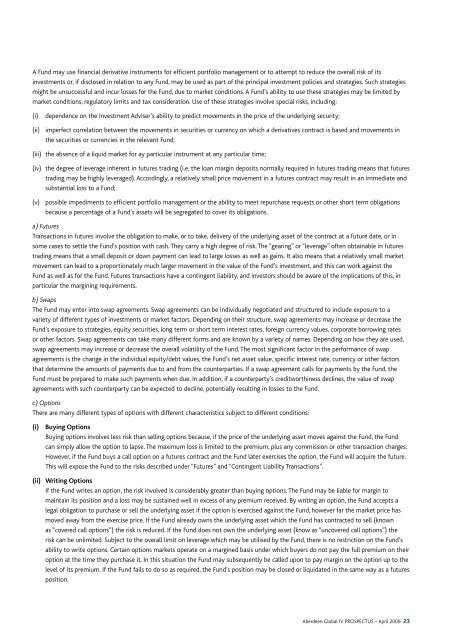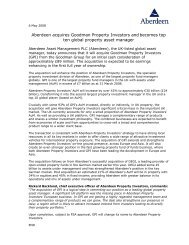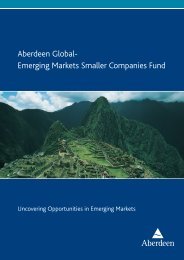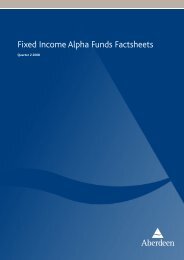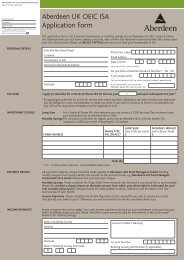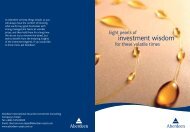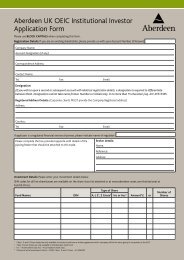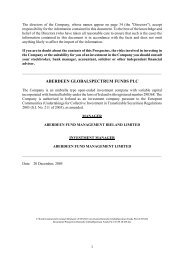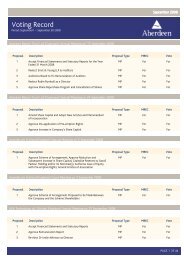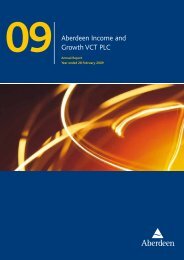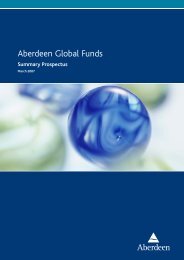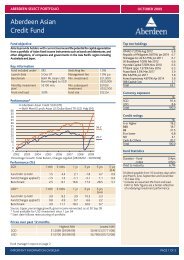Aberdeen Global IV - Aberdeen Asset Management
Aberdeen Global IV - Aberdeen Asset Management
Aberdeen Global IV - Aberdeen Asset Management
You also want an ePaper? Increase the reach of your titles
YUMPU automatically turns print PDFs into web optimized ePapers that Google loves.
A Fund may use financial derivative instruments for efficient portfolio management or to attempt to reduce the overall risk of itsinvestments or, if disclosed in relation to any Fund, may be used as part of the principal investment policies and strategies. Such strategiesmight be unsuccessful and incur losses for the Fund, due to market conditions. A Fund’s ability to use these strategies may be limited bymarket conditions, regulatory limits and tax consideration. Use of these strategies involve special risks, including:(i)dependence on the Investment Adviser’s ability to predict movements in the price of the underlying security;(ii) imperfect correlation between the movements in securities or currency on which a derivatives contract is based and movements inthe securities or currencies in the relevant Fund;(iii) the absence of a liquid market for ay particular instrument at any particular time;(iv) the degree of leverage inherent in futures trading (i.e. the loan margin deposits normally required in futures trading means that futurestrading may be highly leveraged). Accordingly, a relatively small price movement in a futures contract may result in an immediate andsubstantial loss to a Fund;(v) possible impediments to efficient portfolio management or the ability to meet repurchase requests or other short term obligationsbecause a percentage of a Fund’s assets will be segregated to cover its obligations.a) FuturesTransactions in futures involve the obligation to make, or to take, delivery of the underlying asset of the contract at a future date, or insome cases to settle the Fund’s position with cash. They carry a high degree of risk. The “gearing” or “leverage” often obtainable in futurestrading means that a small deposit or down payment can lead to large losses as well as gains. It also means that a relatively small marketmovement can lead to a proportionately much larger movement in the value of the Fund’s investment, and this can work against theFund as well as for the Fund. Futures transactions have a contingent liability, and investors should be aware of the implications of this, inparticular the margining requirements.b) SwapsThe Fund may enter into swap agreements. Swap agreements can be individually negotiated and structured to include exposure to avariety of different types of investments or market factors. Depending on their structure, swap agreements may increase or decrease theFund’s exposure to strategies, equity securities, long term or short term interest rates, foreign currency values, corporate borrowing ratesor other factors. Swap agreements can take many different forms and are known by a variety of names. Depending on how they are used,swap agreements may increase or decrease the overall volatility of the Fund. The most significant factor in the performance of swapagreements is the change in the individual equity/debt values, the Fund’s net asset value, specific interest rate, currency or other factorsthat determine the amounts of payments due to and from the counterparties. If a swap agreement calls for payments by the Fund, theFund must be prepared to make such payments when due. In addition, if a counterparty’s creditworthiness declines, the value of swapagreements with such counterparty can be expected to decline, potentially resulting in losses to the Fund.c) OptionsThere are many different types of options with different characteristics subject to different conditions:(i) Buying OptionsBuying options involves less risk than selling options because, if the price of the underlying asset moves against the Fund, the Fundcan simply allow the option to lapse. The maximum loss is limited to the premium, plus any commission or other transaction charges.However, if the Fund buys a call option on a futures contract and the Fund later exercises the option, the Fund will acquire the future.This will expose the Fund to the risks described under “Futures” and “Contingent Liability Transactions”.(ii) Writing OptionsIf the Fund writes an option, the risk involved is considerably greater than buying options. The Fund may be liable for margin tomaintain its position and a loss may be sustained well in excess of any premium received. By writing an option, the Fund accepts alegal obligation to purchase or sell the underlying asset if the option is exercised against the Fund, however far the market price hasmoved away from the exercise price. If the Fund already owns the underlying asset which the Fund has contracted to sell (knownas “covered call options”) the risk is reduced. If the Fund does not own the underlying asset (know as “uncovered call options”) therisk can be unlimited. Subject to the overall limit on leverage which may be utilised by the Fund, there is no restriction on the Fund’sability to write options. Certain options markets operate on a margined basis under which buyers do not pay the full premium on theiroption at the time they purchase it. In this situation the Fund may subsequently be called upon to pay margin on the option up to thelevel of its premium. If the Fund fails to do so as required, the Fund’s position may be closed or liquidated in the same way as a futuresposition.<strong>Aberdeen</strong> <strong>Global</strong> <strong>IV</strong> PROSPECTUS – April 2009 23


